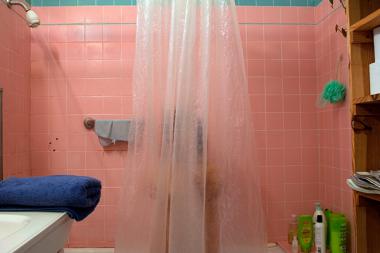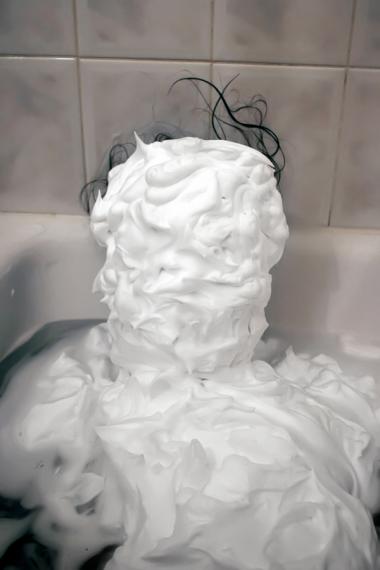October 10, 2014 - 16:46

Shower (2008)

White (2008)

In a creative interpretation of the traditional concept of portraiture, artist Laura Swanson created Anti-Self-Portraits, a series of inkjet prints in which Swanson photographs herself “hiding in plain sight” (lauraswanson.com). As explained by Rosemarie Garland-Thomson, one of the ways in which a portrait tells a story is how “it shows the distinctive characteristics of its subject in order to make that subject as legible as possible to the viewer” (Garland-Thomson 25). However, Swanson’s Anti-Self-Portraits deny the conventions of portraiture since she is hardly legible to the viewer at all. As further stated by Garland-Thomson, “[p]hotos absolve viewers of responsibility to the objects of their stares at the same time they permit a more intense form of staring than an actual social interchange might support” (Garland-Thomson 58). Typically, self portraits say something about the subject, but Swanson’s Anti-Self-Portraits do the opposite: they expose the personality of the viewer. In an artist’s statement about her work, Swanson explains that these photos are:
“less about shame or insecurities of the body, and more of an examination of the psychological process of being viewed and the desire to look at (or look away from) physical difference. . . . At its most critical, these photographs are a response to the problematic images that gawk at otherness -- images that continue to stigmatize many groups of people” (lauraswanson.com).
These Anti-Self-Portraits reveal the lengths that an audience is willing to go to in order to catch a glimpse of otherness. Swanson brings us in to one of the most intimate settings on one’s life — the bathroom — in her portraits Shower (2008) and White (2008); in doing this, Swanson exposes the invasive of the generally able-bodied public and the stifling discomfort inflicted upon the recipients of that voyeurism.
In the first of two images I will analyze from Anti-Self-Portraits, Shower (2008) turns an ordinary scene from daily life into an uncomfortable interchange between viewer and subject. The bathroom in Shower is rather average and the portrait could be a scene in any random home in the U.S., but Swanson’s barely concealed otherness adds intrigue to the photo. The portrait is set in a bathroom with the shower’s salmon-colored tiles as the primary backdrop. In the upper left corner, a white shower nozzle sprays down into the tub where Swanson stands behind a bunched-up clear shower curtain. Swanson positions herself behind the curtain with her arms raised as though she is holding the folds in tier to cover her naked body; she is obscured enough so that we cannot clearly see her nudity, but not so much that we cannot tell that she has a non-normative physique. A variety of shampoos, conditioners, and soaps decorate the lower right ledge of the tub. On the righthand side of the frame, a wooden shelf peeks into view with magazines and toilet paper. Opposite the frame, the corner of a white sink juts into the frame with a dark blue towel folded and placed on the edge.
The subject is framed by the expanse of the tiled walls behind her and the pillar of the plastic shower curtain. Her below average height is emphasized as the top rungs of the curtain stay out of sight. Although we have no place in her bathroom, Swanson is forced to seek meager protection behind the clear shower curtain. The curtain is gathered at the center of the rod so that if Swanson wishes to cover herself she must remain hidden behind the narrow, two-foot space behind the drape. With our intrusive gaze present, she cannot continue with her routine is she is frozen in this space shielding herself from our view. Our gaze impacts her ability to carry out regular activity. This phenomenon is similar to daily-life interactions with those who have visible differences — excessive staring can impede one’s ability to carry out day-to-day activities.
Furthermore, as viewers, we are unsatisfied by the hazy image we see of Laura and there exists a desire to pull back the curtain and reveal who is concealed behind it. In any other situation, if we were to stumble into someone’s bathroom and find them showering, we would turn away and shut the door. However, since it is a person with a visible “otherness” (like Laura), we yearn to look longer than normal to discern her difference. Our typical sense of judgement and morality is altered when we look at someone with a disability, yet those who receive our gaze are still impacted by it. Our lack of restraint does not translate into lack of embarrassment for those who are looked at.
Similar to Shower, White is another portrait that is set in a bathroom, but we look at it through a difference sense of intimacy: instead of the subject’s nudity being the privacy invaded through extensive observation, our proximity to the subject established a different level of infringement. In White, Swanson lies in a bathtub with her body covered in shaving cream. The photo is framed so close to Laura’s body that our sight does not even extend beyond the second row of white tiles. The outer walls of the bathtub are not even included in our vision.
In terms of pose, Swanson is backed up against the inner edge of the tub, and almost every visible part of her body is coated in white shaving cream. This top-to-bottom covering inevitably makes it difficult to breathe as her nose and mouth are covered, too. By sequestering herself from our gaze, Swanson is subject to extreme discomfort, both physically and metaphorically. The only discernible parts of her identity are the few stray black hairs that cling to the white tiles behind her head. These few bits of hair and the vague shape of her head and torso are the only markers that the subject is a person beneath all the foam. In order to escape our prying gaze, Swanson becomes a mass of whiteness, her personhood is obscured by her method of concealment. Because we can hardly see her at all as she hides from view, we cannot even identify who she is as an individual; we can only imagine and pass judgement as to what she looks like beneath the surface. Just as in regular life contexts, people struggle to see her for who she truly is when she hides herself in attempts to evade judgments based on her disability.
Additionally, the perspective from which we see her is from an extreme downward angle, almost as if we were climbing into the bathtub and sitting on top of her. This position is incredibly intrusive because even when Swanson has resorted to bathing in shaving cream to remain out of sight, we disregard her wish to remain hidden and yearn to know what lies beyond the white.
By placing the spectator in highly voyeuristic positions, Swanson’s Anti-Self-Portraits effectively call out her audience for their violative gaze and disrespect for those with visible differences. Swanson’s discomfort is evident in both Shower and White, and yet we still stare. Even though these portraits were taken in intimate spaces, we cannot tell that much about the subject because the kind of viewing we participate in is not to better understand the subject, but simply to ogle at them for our own pleasure. Moreover, the fact that these photos take place in the bathroom demonstrates how willing we are to peer into these personal spaces in order to witness Swanson’s physical difference; not only are we violating her with our sight, but also by the fact that we are willing to invade these places with complete disregard for her privacy.
There is a clear lack of shame in the viewers because of our relentless gaze, and yet we are hyper aware of our gaze because of the privacy of these images. To quote Garland-Thomson once more, “[s]taring registers the perception of difference and gives meaning to impairment by marking it as aberrant. . . . [It] creates an awkward partnership that estranges and discomforts both viewer and viewed” (Garland-Thomson 57). Just like in daily life when we encounter those with visible differences, we are ashamed to stare but simultaneously manage to sneak a peek. In these interactions between normative and non-normative bodies, we are very aware of the fact that we are staring and we fear being caught. Swanson plays upon this desire to stare and simultaneous fear of discovery by combining two taboo situations in which to stare at others: when otherness is involved and when we step into the private spheres of another’s life. The relationship between viewer and subject in Anti-Self-Portraits can be translated into real-world interactions with individuals with disabilities. Although we are not always looking at people with disabilities in their own bathrooms, the way that we stare is still an unacceptable violation on their personal lives.
Works Cited
Garland-Thomson, Rosemarie. "Picturing People With Disabilities, Classical Portraiture as a Reconstructive Narrative." Re-presenting Disability: Activism and Agency in the Museum. By Richard Sandell, Jocelyn Dodd, and Rosemarie Garland-Thomson. London: Routledge, 2010. 23-39. Print.
Garland-Thomson, Rosemarie. "The Politics of Staring: Visual Rhetorics of Disability in Popular Photography." Disability Studies: Enabling the Humanities. By Sharon L. Snyder, Brenda Jo Brueggemann, and Rosemarie Garland-Thomson. New York: Modern Language Association of America, 2002. 56-75. Print.
Swanson, Laura. "Anti-Self-Portraits." Lauraswanson.com. Laura Swanson, 2014. Web. 10 Oct. 2014.
